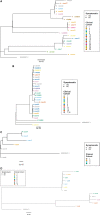Utility of SARS-CoV-2 Genomic Sequencing for Understanding Transmission and School Outbreaks
- PMID: 36795555
- PMCID: PMC9990487
- DOI: 10.1097/INF.0000000000003834
Utility of SARS-CoV-2 Genomic Sequencing for Understanding Transmission and School Outbreaks
Abstract
Objective: An understanding of severe acute respiratory syndrome coronavirus-2 (SARS-CoV-2) transmission in schools is important. It is often difficult, using epidemiological information alone, to determine whether cases associated with schools represent multiple introductions from the community or transmission within the school. We describe the use of whole genome sequencing (WGS) in multiple schools to investigate outbreaks of SARS-CoV-2 in the pre-Omicron period.
Study design: School outbreaks were identified for sequencing by local public health units based on multiple cases without known epidemiological links. Cases of SARS-CoV-2 from students and staff from 4 school outbreaks in Ontario underwent WGS and phylogenetic analysis. The epidemiological clinical cohort data and genomic cluster data are described to help further characterize these outbreaks.
Results: A total of 132 positive SARS-CoV-2 cases among students and staff from 4 school outbreaks were identified with 65 (49%) of cases able to be sequenced with high-quality genomic data. The 4 school outbreaks consisted of 53, 37, 21 and 21 positive cases; within each outbreak there were between 8 and 28 different clinical cohorts identified. Among the sequenced cases, between 3 and 7 genetic clusters, defined as different strains, were identified in each outbreak. We found genetically different viruses within several clinical cohorts.
Conclusions: WGS, together with public health investigation, is a useful tool to investigate SARS-CoV-2 transmission within schools. Its early use has the potential to better understand when transmission may have occurred, can aid in evaluating how well mitigation interventions are working and has the potential to reduce unnecessary school closures when multiple genetic clusters are identified.
Copyright © 2023 Wolters Kluwer Health, Inc. All rights reserved.
Conflict of interest statement
The authors have no conflicts of interest to disclose.
Figures


References
-
- (CDC) CfDCaP. COVID-19 guidance for schools Kindergarten to Grade 12. 2021. Available at: https://www.cdc.gov/coronavirus/2019-ncov/community/schools-childcare/sc.... Accessed June 9, 2021.
-
- Table OS. School operation for the 2021-2022 academic year in the context of the COVID-19 pandemic. 10.47326/ocsat.2021.02.38.1.0.
-
- (Ontario) OAfHPaPPH. COVID-19 in Ontario: Elementary and Secondary School Outbreaks and Related Cases, August 30, 2020 to April 24, 2021. Queen’s Printer for Ontario; 2021.
-
- (NCIRS) NCfIRaS. COVID-19 in Schools—the Experience in NSW. National Centre for Immunisation Research and Surveillance (NCIRS); 2020.
-
- Environment NIfPHat. Children, School and COVID-19. Ministry of Health WaS; 2020.
MeSH terms
LinkOut - more resources
Full Text Sources
Medical
Miscellaneous

